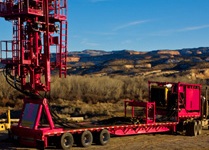The Fracking Frenzy's Impact on Women
 Hydraulic fracturing, or "fracking," has generated widespread media attention this year. The process, which injects water and chemicals into the ground to release "natural" gas and oil from shale bedrock, has been shown to contribute significantly to air and water pollution and has even been linked to earthquakes. But little has been reported on the ways in which fracking may have unique impacts on women. Chemicals used in fracking have been linked to breast cancer and reproductive health problems and there have been reports of rises in crimes against women in some fracking "boom" towns, which have attracted itinerant workers with few ties to the community.
Hydraulic fracturing, or "fracking," has generated widespread media attention this year. The process, which injects water and chemicals into the ground to release "natural" gas and oil from shale bedrock, has been shown to contribute significantly to air and water pollution and has even been linked to earthquakes. But little has been reported on the ways in which fracking may have unique impacts on women. Chemicals used in fracking have been linked to breast cancer and reproductive health problems and there have been reports of rises in crimes against women in some fracking "boom" towns, which have attracted itinerant workers with few ties to the community.
Toxins in Fracking Process Linked to Breast Cancer
Not only has the chemical cocktail inserted into the ground been shown to contaminate groundwater and drinking water, but fracking fluid also picks up toxins on its trip down to the bedrock and back up again that had previously been safely locked away underground. Chemicals linked to cancer are present in nearly all of the steps of extraction -- in the fracking fluids, the release of radioactive and other hazardous materials from the shale, and in transportation and drilling related air pollution and contaminated water disposal.
Some reports indicate that more than 25 percent of the chemicals used in natural gas operations have been linked to cancer or mutations, although companies like Haliburton have lobbied hard to keep the public in the dark about the exact formula of fracking fluids. According to the U.S. Committee on Energy and Commerce, fracking companies used 95 products containing 13 different known and suspected carcinogens between 2005 and 2009 as part of the fracking fluid that is injected in the ground. These include naphthalene, benzene, and acrylamide. Benzene, which the U.S. EPA has classified as a Group A, human carcinogen, is released in the fracking process through air pollution and in the water contaminated by the drilling process. The Institute of Medicine released a report in December 2011 that links breast cancer to exposure to benzene.
Up to thirty-seven percent of chemicals in fracking fluids have been identified as endocrine-disruptors -- chemicals that have potential adverse developmental and reproductive effects. According to the U.S. EPA, exposure to these types of chemicals has also been implicated in breast cancer.
The Marcellus Shale in the northeast part of the United States also naturally contains radioactive materials, including radium, which is largely locked away in the bedrock. The New York's Department of Environmental Conservation (DEC) analyzed 13 samples of water, contaminated by the fracking process, as a result of the hydraulic fracturing of the shale during the extraction process. The DEC found that the resulting water contained levels of radium-226, some as high as 267 times the limit for safe discharge into the environment and more than 3000 times the limit safe for people to drink. One gas well can produce over a million gallons of contaminated water. A New York Times expose in 2011, released secret EPA documents that illustrated how this water is sometimes sent to sewage plants that are not designed to process the dangerous chemicals or radiation which in some instances are used in municipal drinking supplies or are released into rivers and streams that supply drinking water.
Emerging data points to a problem requiring more study. In the six counties in Texas which have seen the most concentrated gas drilling, breast cancer rates have risen, while over the same period the rates for this kind of cancer have declined elsewhere in the state. The average of the six counties' rates has risen from 58.7 cases per 100,000 people in 2005 to about 60.7 per 100,000 in 2008. Similarly, in western New York, where traditional gas drilling processes have been used for decades before hydrofracking came along, has been practiced for nearly two centuries, rural counties with historically intensive gas industry activity show consistently higher cancer death rates (PDF) than rural counties without drilling activity. For women, this includes breast, cervix, colon, endocrine glands, larynx, ovary, rectal, uterine, and other cancers.
Toxins linked to Spontaneous Abortion and Birth Defects
Certain compounds, such as toluene, that are released as gas at the wellhead and also found in water contaminated by fracking have the potential to harm pregnant women or women wishing to become pregnant. According to the U.S. EPA, studies have shown that toluene can cause an assortment of developmental disorders in children born to pregnant women that have been exposed to toulene. Pregnant women also carry an increase risk of spontaneous abortion from exposure to toluene. Wyoming, which contains some of the most active drilling fields in the country, failed to meet federal standards for air quality due to fumes containing toluene and benzene in 2009.
Sandra Steingraber, an acclaimed ecologist and author of "Raising Elijah" -- a book on how to raise a child in an age of environmental hazards, takes the strong stand that fracking violates a woman's reproductive rights. "If you want to plan a pregnancy and someone else's chemicals sabotage that -- it's a violation of your rights as a woman to have agency over your own reproductive destiny," she said.
Steingraber sees banning fracking as an issue that both the pro-choice and anti-abortion camps can rally behind. She has been giving talks on why opposition to fracking should be considered a feminist issue. The author won a Heinz award -- which recognizes individuals for their contributions in areas including the environment -- for her work on environmental toxins. She dedicated the $100,000 prize to the fight against fracking.
Crimes Against Women on the Rise in Some Energy Boom Towns
Beyond concerns about cancer and toxins are other societal ills related to fracking that disproportionately impact women. Some areas across the country where fracking has boomed have noted an increase in crime -- including domestic violence and sexual assault. In Dickinson, North Dakota, there has been at least a 300% increase in assault and sex crimes over the past year. The mayor has attributed the increase in crime to the oil and "natural" gas boom in their area.
The Executive Director of the Abuse & Rape Crisis Center in Bradford County, Pennsylvania, Amy Miller, confirmed that there has been an increase in unknown assailant rapes since the gas industry moved into the region -- which are much harder to prosecute. Miller also noted that domestic abuse has spiked locally, with the cases primarily from gas industry families. The county has more than 700 wells drilled, with more than 300 of these operational, and another 2,000 drilling permits have been issued.
The Gas Industry's Pink Rig
Even though fracking and drilling are dependent on a potpourri of carcinogenic chemicals, big energy companies don't hesitate to slap on pink paint in PR campaigns championing breast cancer awareness.
In 2009, a "natural" gas drilling rig in Colorado was painted pink with a percentage of the daily profits from the unit going to the Breast Cancer Foundation. This and other showy gestures by the shale gas and oil industry appear to do little to alleviate concerns about the impact that fracking chemicals and practices may be having on public health and safety.





Comments
This article seems
This article seems more-or-less sound but I have to ask, why link something from RussiaTimes.com? Everyone knows it's propaganda, even the people who make it, and I'm seriously questioning CMD's accuracy now that I've noticed that. Sketchy.
Reply to comment | Center for Media and Democracy
This is my first time pay a quick visit at here and i am actually pleassant to read all at alone place.
Reply to comment | Center for Media and Democracy
Since the admin of this web page is working, no doubt very shortly it
will be famous, due to its feature contents.
Fracking linked to earthquakes
The article links to the statement "fracking has even been linked to earthquakes." This information can easily be found on a whole host of sites. For example, here's that information in the LA Times: http://www.latimes.com/news/nation/nationnow/la-na-nn-fracking-earthquakes-ohio-20120309,0,5410696.story
Additionally, a link to the Ohio Department of Natural Resources, which states: "The Ohio Department of Natural Resources (ODNR) developed the new regulations after researching the link between a series of seismic events in the Youngstown area and a brine disposal well." http://www.ohiodnr.com/home_page/NewsReleases/tabid/18276/EntryId/2711/Ohios-New-Rules-for-Brine-Disposal-Among-Nations-Toughest.aspx
Eartquakes
Hydraulic Fracturing or Fracking has not been linked to earthquakes. The recent earthquakes in Ohio were directly linked to injection wells. Injection wells have been used in Ohio and the US for decades, even prior to the fracking frenzy. The well in question was improperly drilled into a fault zone thus causing the tremors. Read the story at http://www.syracuse.com/news/index.ssf/2012/03/ohio_gas-drilling_injection_we.html
EnergyWire reports on USGS study - earthquakes and fracking
Robb, you may want to check out the recently released USGS study on this issue. Here is an EnergyWire report on it.
EnergyWire article and USGS Abstract.
USGS is studying this potential relationship and has posted an abstract. See link directly below:
USGS Abstract on Earthquake Relationship to Drilling
ENERGYWIRE: EARTHQUAKES:
'Remarkable' spate of man-made quakes linked to drilling, USGS team says
Mike Soraghan, E&E reporter
Published: Thursday, March 29, 2012
Picture (Device Independent Bitmap)A rash of earthquakes in the middle of the country appears to be related to oil and gas drilling, according to a group of researchers at the U.S. Geological Survey.
"A remarkable increase in the rate of [magnitude-3.0] and greater earthquakes is currently in progress," the scientists state in the abstract for their study. "A naturally-occurring rate change of this magnitude is unprecedented outside of volcanic settings or in the absence of a main shock."
The surge in temblors is "almost certainly man-made," they found, and all of the potential causes they explore in the paper relate to drilling, or more specifically, deep underground injection of drilling waste.
Casting the quakes as a trend could make it more difficult for oil and gas companies and state regulators to discount the earthquakes related to drilling as rare, isolated events. That, in turn, could provide new ammunition to critics who want stronger regulations, or even a ban on drilling.
The group of scientists, led by geophysicist William Ellsworth, is to present the paper next month at the annual meeting of the Seismological Society of America in San Diego. The abstract for their study has already been posted.
The study found that the frequency of earthquakes started rising in 2001 across a broad swath of the country between Alabama and Montana. In 2009, there were 50 earthquakes greater than magnitude-3.0, the abstract states, then 87 quakes in 2010. The 134 earthquakes in the zone last year is a sixfold increase over 20th century levels.
The surge in the last few years corresponds to a nationwide surge in shale drilling, which requires disposal of millions of gallons of wastewater for each well. According to the federal Energy Information Administration, shale gas production grew, on average, nearly 50 percent a year from 2006 to 2010.
"This is very peculiar, what's going on," Ellsworth said in an interview with EnergyWire.
But there are disagreements about whether some of the events were triggered by activity related to drilling. And the abstract states, "It remains to be determined how they are related to either changes in extraction methodologies or the rate of oil and gas production."
The abstract states that a "modest" increase in quake activity near the Colorado-New Mexico border starting about 10 years ago was "due to" increased seismicity in a nearby coalbed methane field in the Raton Basin.
That contradicts a USGS report that said "we do not have any firm evidence of a direct relationship between the fluid disposal and the earthquake swarm." But Ellsworth said that conclusion is dated.
"The 2002 report was very cautious," he said. "Our report is based on another 10 years of data."
More recently, the study abstract says, another spate of tremors that began in 2009 "appears to involve a combination of source regions of oil and gas production." That combination includes a "swarm" of earthquakes in north-central Arkansas tied to underground injection of wastewater from hydraulic fracturing (Greenwire, June 22, 2011), along with other tremors in central and southern Oklahoma.
In Oklahoma, the rate of earthquakes greater than magnitude 3.0 "abruptly increased" from an average of 1.2 quakes a year for the previous half-century to more than 25 in 2009. But a study by the Oklahoma Geological Survey released earlier in 2011 found that most of the state's seismic activity did not appear to be tied to injection wells, although it said more investigation was needed.
In their study, the USGS scientists did not include a magnitude-4.0 earthquake in January in Youngstown, Ohio, that scientists have linked to underground injection of fracturing wastewater, or a magnitude-5.6 earthquake near Oklahoma City in November.
But another paper to be presented at the San Diego conference by University of Memphis seismologist Stephen Horton concludes that the November quake was "possibly triggered" by nearby waste injection wells.
There are 181 injection wells in the Oklahoma county where the November earthquake happened. But Ellsworth said researchers are also looking at "enhanced oil recovery" wells where oil and water are withdrawn.
"We don't know exactly what's going on, whether it's related to injection or withdrawal," he said. "We don't understand why it went up so quickly in Oklahoma, where recovery has been used for years."
The USGS paper is to be presented by Ellsworth, a former president of the Seismological Society, who is at the Geological Survey's Earthquake Science Center in Menlo Park, Calif.
The paper does not link any of the earthquakes to hydraulic fracturing, or "fracking," itself, but to injection wells that accept wastewater from "fracked" production wells.
Induced seismicity
Geologists have known for decades that deep injection of industrial waste can lubricate faults and unleash earthquakes. One of the most famous instances of man-made earthquakes, or "induced seismicity," occurred in the late 1960s at the Rocky Mountain Arsenal near Denver, where the Army manufactured chemical weapons.
Man-made earthquakes are rare. And quakes caused by underground injection have not caused injuries. Still, there are more earthquakes linked to injection of oil and gas waste than there are documented cases of drinking-water contamination linked to hydraulic fracturing.
And in the last year, earthquakes in Arkansas and Ohio near heavy drilling areas have set people on edge, forced the shutdown of wells and inspired new restrictions on injection wells (Greenwire, Jan. 5). No injuries were reported from those quakes, but they have caused some to question drilling practices and strengthened the opposition of others.
Earthquakes unleashed by drilling wastewater fall into a gap in federal environmental laws. Oil and gas producers are exempt from provisions of the hazardous waste statutes designed to prevent industrial waste injection wells from triggering earthquakes (EnergyWire, March 12). States can adopt stricter rules. Ohio is adding additional seismic testing in the wake of its tremors, but other states have not followed suit.
U.S. EPA has a team developing a series of recommendations to suggest to state regulators on earthquakes. The team started work last June and says it hopes the recommendations will help in "managing or minimizing" earthquakes triggered by oil and gas waste injection wells (EnergyWire, March 15).
In addition, the National Academy of Sciences is studying how several forms of energy production trigger earthquakes. According to the NAS website, the group's report, "Induced Seismicity Potential in Energy Technologies," is due out this spring.
Good points, and many more to consider
The impact of fracking on women's health and well being extends beyond the physical. Many women (and men and children) living in frack-lands in Pennsylvania and other states, and those in threatened New York and threatened countries (of which there are many) are experiencing extreme stress, indeed trauma. The mental and emotional impacts are severe.
In some cases there's guilt for having signed a lease, and now knowing the poisons in the air, water, and croplands will likely harm one's children. Knowing that the illnesses caused by these toxins may not manifest for months, years, or even decades, adds an incredible strain, especially because we know we can never trace these illnesses back to the fracking companies -- who will deny responsibility in any case and who may well have changed their name or gone through a merger or be otherwise untraceable.
In cases where fracking is occurring already, the community is often fractured (fracked). Some members of the community welcome it for the perceived job growth and economic prosperity (although it is inevitably a boom that will bust). Others recognize the environmental, health, and quality-of-life degradation. Sometimes families are divided over the issue, and some families fracture.
A very well researched and written story in No Frack Almanac's most recent issue delves into the subject of rent spikes and foreclosures leading to homelessness in fracked Pennsylvania. When one's water is poisoned, one's home loses all value, so many people are stuck in untenable situations, with nowhere to turn. I know of at least one family where the teen-aged children decided to leave home and move in with relatives in other states, to avoid the rashes, headaches, and respiratory illnesses they got from living at home near shale-gas fracking.
Beyond this, the stress and sleeplessness among many antifracktivists is taking a toll. I know dozens of dedicated people who are working night and day to protect their families, communities, and future -- to the detriment of their own health and livelihoods. They know they are literally fighting for their lives and feel they have no choice.
Now if only there were tens of thousands more of them -- the stress level of each would lighten.
"The mental and emotional impacts are severe."
The environmental community is causing a crisis to create this "mental and emotional impact" so this created stress will cause people to panic! "Fracking" is a process that has been used in the United States for 50+ years. I used to work around this process back in the early 1980's and had my hands in the fluids used in this process. It was termed "hydraulic fracturing" for many years until someone came up with a term that left leaning individuals could remember. The fact is:
1) The process has been used for 50+ years!
2) Not a single case has been proven, as of today, that FRACKING caused water contamination from 5,000 feet below the earths surface to the water table. Yes, there have been a few spills at the surface, but they are cleaned up, including the soil containing the fluids.
3) If these fluids were so toxic, I and many of my fellow workers would have died long ago from cancer. Many of us, that I have stayed in touch with are still in the business working and paying taxes. I am still working now in the pipeline business.
4)The price on Natural Gas is at a 10 year low, (about $2.50 per TCF) where it was around $9.50 per TCF, about 10 years ago.
5) If we would be allowed to drill on something other then private property, we could also reduce the cost of a gallon of gas!
I have to go back to work now, after a brief pause to stop this environmental madness that is taking our country down!! I will continue to pay good tax money so our government can spend it in a ridiculous manner, especially when it helps to fund these groups that use BS instead of facts to justify a cause!
RE: Industry Mouthpiece Above WRONG
The gas fracking companies are invested billions deep in this new process and as it is still cheaper to spend hundreds of millions to corrupt the evidence and decision makers than it is to stop. Here are a few of the facts WE KNOW about slickwater horizontal hydraulic fracturing.
Land values go down in the entire region after fracking occurs (and violates mortgage agreements). Pollutants contaminate neighbors water and air and are noisy (criminal trespass), as well as drill under their property. Truck activity does damage to local roads. What is added to the fracking fluid is toxic. That injected fluid can and does make it to the groundwater. The flowback also comes up laced with toxins from deep underground, like radium, heavy metals, and salts. Methane in the water near fracking sites becomes higher after drilling. Earthquakes increase in regions that are fracked. The industry has supressed and denied all information about how this new process, sharing a different processes name, is dangerous. Deep injection wells have around a 15% failure rate. All studies about fracking that give it a clean bill of health have been corrupted by the frackers influence. Every study critical of the new practice has been attacked furiously.
Under the guise of job creation and reduced reliance on foreign Natural Gas, we are letting companies poison us. That their arguments are false means nothing when hundreds of millions of dollars are spread among the politicians, advertisements, academia, etc..
But remember that the costs of treating people sick from this process will far outweigh any short-term benefit we get from this process, and those costs will be bourne by our communities, local, state, and federal governments as these companies deny responsibility, and be far higher than any short-term benefit we receive, not to mention the other costs.
shill
shill